Three Great Events
17 February
Well, the journey down was not auspicious.
We left for a mini-break in London and travelled down by train. Just after Nuneaton
we were told that there were problems with the overhead power cables at Watford.
At Rugby we stopped and took on all the passengers from another train travelling
south. At Milton Keynes, we were all told to get off the train. We were told that
the next train would stop for us but it didn't. A second train arrived and all the
people from that got off as well.
At that point we were told that we would be taken to
London on coaches so we all went up to the concourse. Then they decided to use the
second train after all, so there was a mass rush back to the platform. Mostly,
everyone was even tempered about it and staff tried their best in the face of
complete lack of information. But we shall complain as little provision was made for
a person in a wheelchair.
Luckily, we had nothing planned for the evening so we didn't feel under any
time pressure at all. We have a pleasant Valentine's Day meal at Café
Uno.
Then came three great events in a row on the Saturday.
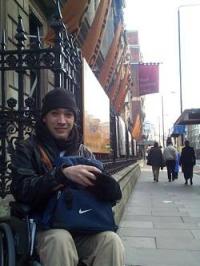 The Aztecs exhibition at the Royal Academy was just stunning. I came out of it
in a state of shock. In the space of eleven rooms, I had seen treasures of great
beauty and spirituality and had been introduced to a world view wholly alien to
our own but not unfathomable.
The Aztecs exhibition at the Royal Academy was just stunning. I came out of it
in a state of shock. In the space of eleven rooms, I had seen treasures of great
beauty and spirituality and had been introduced to a world view wholly alien to
our own but not unfathomable.
It was a system based around dualities; light and dark, wet and dry, sun and moon, hot
and cold, life and death. Those who died a violent death were venerated. They would go
to the upper world and walk with the sun. Everyone else went to the lower world. There
was no moral approbation attached to this. It was just another place to go. Warriors
died violent deaths. Sacrificial offerings died a violent death. Women in childbirth
died a violent death. All these walked with the sun. The men walked with the sun from
sunrise until its zenith. The women walked with the sun from its zenith until sunset.
All of this was celebrated in the artifacts. One of the most bizarre was a figurine
wearing a strange bobbled coat. At first I thought that it resembled Papageno's
feathered costume from the first performances of The Magic Flute. It emerged
that the image depicted a priest wearing the flayed skin of a sacrificial offering.
The bobbles were the little lumps of fat under the skin.
This was done as a homage to snakes which slough their skin each year, emerging larger
and more healthy from the old, discarded encasement. It was a metaphor for resurrection.
The priests wore the skin as part of a ritual until it rotted off them. And the
sacrificial victim went on to walk with the sun.
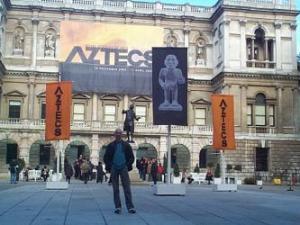

I had been wondering, having introduced my star classification system this year,
whether or not I was being too harsh. I'd award a lot of three stars, a few four
starts and no five stars. Well, now I know why I was setting high standards. It
was to leave room for events like this so that I could give them five stars
because they stand head and shoulders above the rest.
![[Five Stars - Outstanding]](5.gif)
Leaving the Royal Academy, we met up with Gill
and joined the throngs walking down Piccadilly as part of the Peace March.


I've not said anything in the Journal so far about events in the Middle East.
Mostly because it has all felt so inevitable. War will happen because there are
already so many troops there that they have to fight in order to justify the cost
of sending them there. I can find no just cause in this war. It is about oil rights
and one man's desire to finish off his father's war for him. I cannot see that it is
about ousting a tyrant because there are so many at large that to pick on one and not
others seems to be whimsical. And where is the longer game plan? Why is no-one talking
of what might happen in five to ten years.
So, Gill, Ross and I added our voices and our feet to the hundreds upon hundreds of
thousands. Police sources claim 750,000. March sources say anything near to 2,000,000.
Granada News claimed 1,000,000. Sky News claimed 1,500,000. Whatever, it was a lot of
people taking the trouble to make their feelings known. And the remarkable thing about
it was that there were very few large, organised groups there to dominate the
proceedings.
There were families and elderly couples and people in wheelchairs and people in
pushchairs and muslim people and black people and people wearing suits and people
wearing purple hairdos and church groups and social groups and there was Ross and
Gill and me. Alongside all of that, the inevitable Socialist Workers Party ranters
were just a little lost. I'd have to give the whole experience a ripping five stars.
![[Five Stars - Outstanding]](5.gif)
After all that excitement there was just time to fit in a shower and a shave and
a very pleasant meal at Café Rouge in Covent Garden with
Keith before going to the Royal Opera for a
performance of Verdi's Falstaff.
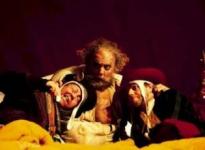

I last saw Falstaff at ENO
in 1997 in a magical production by Matthew Warchus conducted in sprightly fashion
by Oliver von Dohnányi with an ensemble rather than a stellar cast. It
was a complete tonic at the time since it was the beginning of Ross's ME and
life was not looking bright.
This cast was stellar indeed. Bryn Terfel appropriately dominated the action
simply by singing the role he was given and under rather than over-playing
the part. It was full of pathos as well as bluster. Soile Isokoski played Alice
Ford. She sang on one of my favourite disks
of last year - Strauss's Four Last Songs. I was hoping for good things and
was not disappointed. Her voice has a silver shimmer to it. She holds a good line and
gives us words as well as tone. And she seems like quite a game lass too to judge
by her capering.
Stephanie Blythe was an outstandingly fruity mezzo for Quickly; Rebecca Evans
span beautiful lines for her solo spots and was a challenging and forceful Nanetta;
Marie McLaughlin made up the quartet of women with some beautiful singing of
her own. All four acted and reacted together with astonishing aplomb.
For the rest of the men, Robert Tear was an effective Dr Caius and Peter Hoare and
Mario Luperi made much of Bardolf and Pistol. Anthony Michaels-Moore was an
outstanding Ford large of voice and passion and utterly believable in his final
act of forgiveness. The one slightly weak link in the chain was Massimo Giordano
as Fenton. It was to have been Juan Diego Flórez, which would have been
luxury casting but there was an unexplained substitution before the first night.
Orchestrally, it was gorgeous. Anthony Pappano conducted a gossamer version of the
score, full of chuckles and laughter, full of air and beauty, full of earth
and water. It was outstanding.
I should love to give this third event of the day five stars along with the first two
but I can't. And the reason is Graham Vick's heavy-handed, unmusical production.
So, four stars ![[Four Stars - Excellent]](4.gif) for a great night out musically if not theatrically.
for a great night out musically if not theatrically.
A night's sleep and it was down to Tate Modern to see Anish Kapoor's installation
Marsyas which fills the great Turbine Hall from top to bottom and for
its full length. If you've never been in the space that won't mean much too you
but hold in your mind's eye something bigger than the nave of a Gothic cathedral.
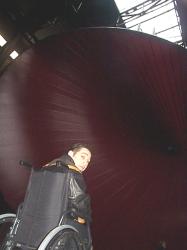

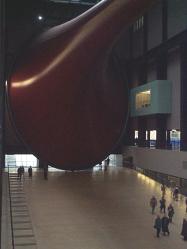
It comprises three great steel rings two at either end of the Hall and the third
halfway down suspended horizontally over the bridge. All three are joined by a wine
red membrane stretched between the end two and wholly supporting the middle one.

It was back in 1998 that I went to the Anish Kapoor
exhibition at the Hayward Gallery and fell in love with his work. This installation
simply confirms my liking and love for his work. On the simple level of being an
object in space it is an astonishing achievement conceptually and technically. But,
being Kapoor, it is more than that. The work inherits its title from Marsyas, a satyr
in Greek mythology who was flayed alive by the God, Apollo. If the object somehow
resembles flesh or viscera stretched out, then maybe that's what it is. Maybe we
are back to those Aztec sacrificial offerings.
One of things that amazed me as Ross and I spent time with the work was how other
people reacted. Small people tended to play with it - which I suspect is what you
are supposed to to - either that or sit in awe and amazement and possible worship it.
Adults either stood slack jawed or laughed or did the art gallery thing of looking
and moving on. I witnessed one guy look at it and say "That is so cool" and
walk on. He spent 10 seconds with the piece. Another French couple managed 20 seconds
before they said "C'est très jolie, ça" and moved on. I have no idea
what they experienced. Personally, my experience was worth a good four stars.
![[Four Stars - Excellent]](4.gif)
 We went to two other shows whilst we were in the building. The first was of
works by Eva Hesse, a sculptor who died very young and was a part of the
avante garde of the 60s in New York. She worked with many materials that
were entirely new then. I didn't like it at all. After everything else we'd seen
this weekend, it felt spiritually impoverished.
We went to two other shows whilst we were in the building. The first was of
works by Eva Hesse, a sculptor who died very young and was a part of the
avante garde of the 60s in New York. She worked with many materials that
were entirely new then. I didn't like it at all. After everything else we'd seen
this weekend, it felt spiritually impoverished.
 The Max Beckman exhibition showed us someone of great capabilities with a superb
draftsman's technique and complete control over his medium and his canvass but what
a sour and general nasty world he inhabited. I think that I should have hated to have
spent more than five minutes in a room with him.
The Max Beckman exhibition showed us someone of great capabilities with a superb
draftsman's technique and complete control over his medium and his canvass but what
a sour and general nasty world he inhabited. I think that I should have hated to have
spent more than five minutes in a room with him.
I can see why Max Beckman was given a show at Tate Modern - I just didn't like his
work or what he had to say about the world. I cannot understand why Eva Hesse was given
this accolade. Her work feels like a good graduate's sketches after something new
without anything ever having been actually achieved. It possibly rates a curiosity
retrospective at a minor gallery but I am sure that their are artists who are more
worthy of the time in that space. I can only offer the both of them a meagre one
star between them. ![[One Star - Poor]](1.gif)
Interestingly, both of them share a common story. Both were of the Jewish faith.
Both had to leave Germany in the late 1930s; Beckman at the height of his powers
having been denounced as a degenerate entartete artist and Hesse as a
very young person. Both went immediately to Amsterdam. Both then emigrated to the
USA. Both had struggles coming to terms with their new lives. Beckman regained
some of his prowess and then died of a heart attack. Hesse's parents divorced,
her mother committed suicide and she had a driven life until a brain tumor killed
her at the age of 34. Much of the artistic life of the Western world during the
late 20th Century is filtered through this story told time and time again. I suspect
that to make that statement publicly would ensure that you were branded as anti-semitic.
A weekend of culture and socialising was completed by lunch with son
Robert. He's well, hanging on in until
his final assessments in the summer. He's now living in his own flat. He has a new
girlfriend, Vivienne, who I shall meet at some point. He's 22 and life seems good.
Which it is.
The journey back was a lot easier than the journey down and we got bumped up
to First Class which is always a treat. It was a splendid weekend all round and
I also managed to acquire some nice, new photographs of
Gill, Robert and
Keith.
 The Aztecs exhibition at the Royal Academy was just stunning. I came out of it
in a state of shock. In the space of eleven rooms, I had seen treasures of great
beauty and spirituality and had been introduced to a world view wholly alien to
our own but not unfathomable.
The Aztecs exhibition at the Royal Academy was just stunning. I came out of it
in a state of shock. In the space of eleven rooms, I had seen treasures of great
beauty and spirituality and had been introduced to a world view wholly alien to
our own but not unfathomable.










 We went to two other shows whilst we were in the building. The first was of
works by Eva Hesse, a sculptor who died very young and was a part of the
avante garde of the 60s in New York. She worked with many materials that
were entirely new then. I didn't like it at all. After everything else we'd seen
this weekend, it felt spiritually impoverished.
We went to two other shows whilst we were in the building. The first was of
works by Eva Hesse, a sculptor who died very young and was a part of the
avante garde of the 60s in New York. She worked with many materials that
were entirely new then. I didn't like it at all. After everything else we'd seen
this weekend, it felt spiritually impoverished.
 The Max Beckman exhibition showed us someone of great capabilities with a superb
draftsman's technique and complete control over his medium and his canvass but what
a sour and general nasty world he inhabited. I think that I should have hated to have
spent more than five minutes in a room with him.
The Max Beckman exhibition showed us someone of great capabilities with a superb
draftsman's technique and complete control over his medium and his canvass but what
a sour and general nasty world he inhabited. I think that I should have hated to have
spent more than five minutes in a room with him.